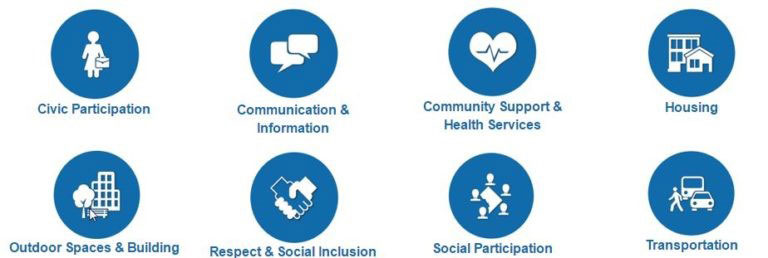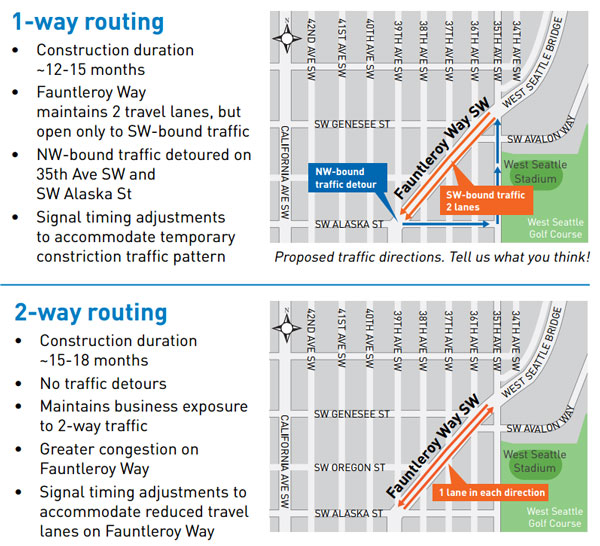Age Friendly Resolution, West Seattle Bridge Encampment Cleanup, SPU Contract Amendment, Fauntleroy Project Update
On Monday, the Full Council adopted the Age Friendly Resolution 31739, expressing Seattle’s commitment to being a more age-friendly city and committing to several areas of continuous improvement across every function of City government.
In August 2016, AARP designated Seattle as the 104th community in the U.S. to be a part of the AARP Network of Age Friendly Communities. But the proposed 2017-2018 budget did not include any funding to implement the improvements that the AARP suggests for Age Friendly Communities.
Consequently, during the 2017-2018 budget deliberations, I proposed an Age Friendly Community Innovation fund that would have allocated $87,500 in 2017 and $175,000 in 2018. Under my proposal, each City Council district would have been eligible to receive grants up to $25,000. Instead of funding the proposal, the Council adopted a Statement of Legislative Intent (SLI) requesting that the Human Services Department (HSD) assess the needs of seniors to determine the need for and use of an age-friendly innovation fund
The AARP Network of Age-Friendly Communities targets improvements in eight domains that influence the health and quality of life for all as we age. “Livability Indicators” include:
On March 22, that the Mayor announced that he was going to allocate $200,000 from the first quarter supplemental budget to for 2017 to fund a series of age-friendly initiatives on environmental, economic, and social factors influencing the health and well-being of older adults. The funding will support organizations that are developing innovative new programs for seniors, nonprofits that provide transportation options for seniors and to fund a technology symposium to create user-friendly online resources for seniors.
Accompanying that funding commitment was a resolution. The resolution was first discussed on March 22, during the Human Services and Public Health Committee meeting. Councilmember Bagshaw, the sponsor of the resolution accepted my amendment that requests the Office of Economic Development (OED) to collaborate with the Mayor’s Office of Senior Citizens to identify opportunities to improve access to employment and training for Seniors, as expressed in Economic Development Policy 4.7 of the City’s 2035 Comprehensive Plan, which states that the City shall “[s]upport efforts to provide training and job placement for older workers and others who may have unique challenges finding employment.” I would like to thank OED Director Brian Surrat and Deputy Director Rebecca Lovell for working on this important amendment with my office.
According to a report funded by the U.S. Department of Labor, the number of individuals in the labor force who are 65 years or older is expected to grow by 75 percent while those who are 25 to 54 is expected to grow by only two percent, which will result in 19 percent of the workforce being comprised of 19.6 million American workers 65 years or older by 2050.
West Seattle Bridge Encampment Cleanup
In late February I asked Seattle Public Utilities (SPU) for an update on the unsanctioned encampment trash cleanup efforts, including the site under the West Seattle Bridge. Again on March 13th, I reached out to SPU after a constituent sent me pictures of the location and I asked if they could send a crew to visit the site and to specifically facilitate garbage pickup in the area with special attention to the bike path.
SPU informed me that their policies did not allow them to clean up an active encampment location. You may recall, that I have been active in supporting – and providing funding for – SPU’s efforts to address the proliferation of garbage around our city, including at unsanctioned homeless encampments. Since the Council has provided significant funding for this work, I was dissatisfied with that response and I reached out to the Mayor’s Office and they agreed with my assessment.
Unfortunately, on March 23rd, there was an attempted assault on a bicyclist under the Bridge at Spokane St and East Marginal Way while commuting home. The West Seattle Blog broke the story, you can read about it here. As I mentioned above the Mayor’s Office had, the week prior, agreed to take action, but the day of the incident they and SPU staff visited the location to complete an assessment, after which they released this blog post.
Outreach to the individuals living outdoors at the location began on Monday to offer services and alternative shelter and they continued those efforts through Wednesday.
Garbage removal began on Wednesday at Spokane St and East Marginal Way. Heavy machinery is being used to remove large amounts of accumulated trash, this effort will continue east to I-5. RV campers under the bridge have been asked to leave trash on the side of the road for SPU to pick up. They are not being asked to move at this time.
I also asked Seattle City Light (SCL) about the lighting under the bridge which has been out since the end of last year. The issue was complicated when the copper wiring associated with the lampposts was stolen. SCL believes they will be able to restore the lighting by Friday evening.
As a sensitive safety issue I will be tracking this and continuing to advocate for the safe cleanup of trash associated with all unsanctioned encampments around the City.
If you want to report illegal dumping, you can call SPU at 684-7587, or utilize the Find It Fix It App, both are effective in making sure that SPU receives information about locations that need cleaning-up. If needles are present, please indicate when reporting. SPU has a goal of picking up needles within 24 hours of reports.
On March 14th I heard Council Bill 118932 in my Committee, this bill would authorize Seattle Public Utilities (SPU) to amend the City’s solid waste disposal contract with Waste Management for waste disposal and transportation services. The amendment would reduce the City’s contracted rate per ton for solid waste disposal for the next several years in exchange for delaying a previously negotiated City option to terminate the contract with Waste Management.
Specifically, the amended contract would discount the current solid waste disposal rate by $2.00 per ton in 2017 and 2019, and $0.50 per ton in 2021. Based on the proposed discounts, SPU – and the rate payers – would benefit from about $8 million in cumulative savings from 2017 to 2023.
The amended contract delays, by five years, the City’s previously negotiated opportunity to end the Waste Management contract (from March 31, 2019 to March 31, 2024).
At the Committee meeting I voted in favor of this bill along with Councilmembers Sawant and O’Brien. By approving the proposed bill, SPU will enjoy $8 million in savings over a 7-year period; and SPU could use the savings to support cash financing of capital improvements, and to reduce the projected 3-year (2018 to 2020) average annual ratepayer increase from 4.4 percent to 4.1 percent—a 0.3 percentage point difference. Since discounts extend to 2024, there is the opportunity for a favorable impact on future anticipated solid waste rate increases currently project by SPU ranging from 2.8 percent to 4.2 percent per year from 2021-2023; however, this is heavily dependent on SPU’s strategic plan update which has yet to be submitted to Council.
The alternative to passing this bill would be to seek a Request for Proposal (RFP), which would bring to bear the competitive process of the market; however, there are no guarantees of savings and we would run the risk of a higher solid waste disposal rate. SPU contends that there are many risks with going to bid at this point in time: 1) a short timeline to develop an RFP, which would make it harder for smaller firms to compete due to costs associated with contracts as large as Seattle’s. 2) A bid process could result in higher rates than the current tonnage rate (Snohomish County pays 25% higher than Seattle despite 33% more volume). 3) A potential loss of quality of service. 4) an immediate loss of $1.2 million in negotiated savings with Waste Management (this is the sum of savings from April 2017 to March 2019, the soonest any potential new solid waste disposal contract could go into effect).
In sum, SPU’s negotiated amendment is compelling because it guarantees lower solid waste rates at low risk while maintaining the quality of service Seattle residents expect. This bill will be heard at Full Council on Monday, April 3rd.
Last month, my staff and I attended a meeting of the newly formed Fauntleroy Way Neighborhood and Business Association to hear their concerns about the project. SDOT hosted public “Walk and Talk” tours of the Fauntleroy Boulevard project area on March 16 and 18 and upon my request included staff from the Office of Economic Development so those staff could begin conversations both about possible design modifications that will minimize impacts to businesses, as well as to begin the conversation about ways to mitigate short-term impacts during construction of the project. I attended the walk-through on the 18th. My staff also attended an earlier meeting at the West Seattle Transportation Coalition.
The project is designed to have a more pedestrian, transit, and bicycle-friendly urban boulevard, in an area with increasing residential density and transit use as well as to provide a gateway entrance on Fauntleroy between Alaskan and 35th. I have heard from many residents of the area that they do not feel safe walking down the hill to patronize the business district in their own neighborhood because of the lack of safe pedestrian connections.
SDOT’s website has an update with the project display boards from the public walk-throughs, which include details about the project.
You can provide feedback on the design, construction and landscaping options here, through March 31.
There are currently two options for construction planning, as shown below:
- 1-way routing, which would maintain 2-travel lanes SW-bound, with NW-bound traffic detoured to 35th and Alaska;
- 2-way routing: 1 traffic lane would be open in each direction
Previous engineering studies for the project were from 2014; a great deal of development in the area has occurred since that time. When, during the course of project, a factor like increased density occurs, it is important to reconsider the assumptions about project impacts. Last year I joined the neighborhood requests for updated studies on traffic impacts anticipated from the project. SDOT agreed and, in its updated engineering study, is including future projected impacts (up to 20 years out). Results are expected in April.
Funding comes from the Move Seattle levy approved by Seattle voters in November, 2015. The origins of the project come from the community, in planning processes dating back to 1999, and the West Seattle Triangle Planning from 2012. Conceptual design started in 2011, with community feedback in 2012, leading to 30% design in 2014. In addition to this long-standing support, I have heard, as mentioned above, some concerns about this project. SDOT expects to complete 90% design in April, with 100% design this summer.
Concerns include loss of right-turn pockets onto Oregon and Avalon, and potential backups; diversion of traffic during construction, and potential backups; MHA/HALA planning, and ST3 planning; in addition, businesses have expressed concern about business access during construction.
SDOT is considering specific modifications to address business’ concerns, and design concerns.
I am hopeful that SDOT, the Office of Economic Development, and the Department of Neighborhoods will coordinate an approach that encourages cooperation with businesses to determine construction impacts, minimize them, and determine whether mitigation measures are necessary when the impacts can’t be minimized, so that we avoid a re-occurrence of what occurred last year on 23rd Avenue in the Central District.
Posted: March 31st, 2017 under Councilmember Herbold, Homelessness, Human Services, Public Health, Seattle Public Utliities, Transportation
Tags: Fauntleroy, Seattle Public Utilities, seniors, West Seattle Bridge



